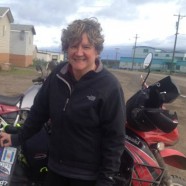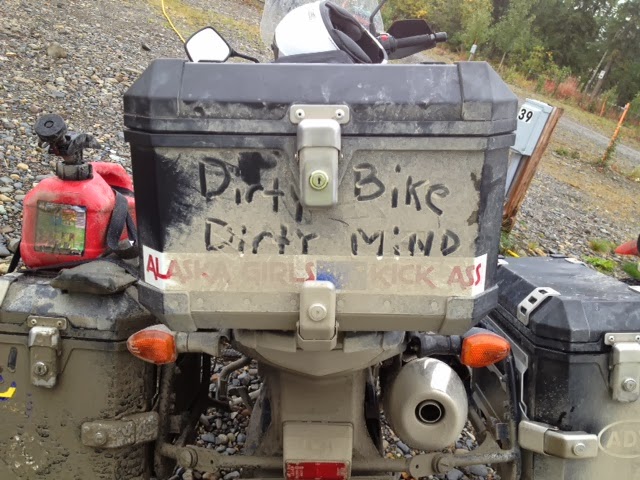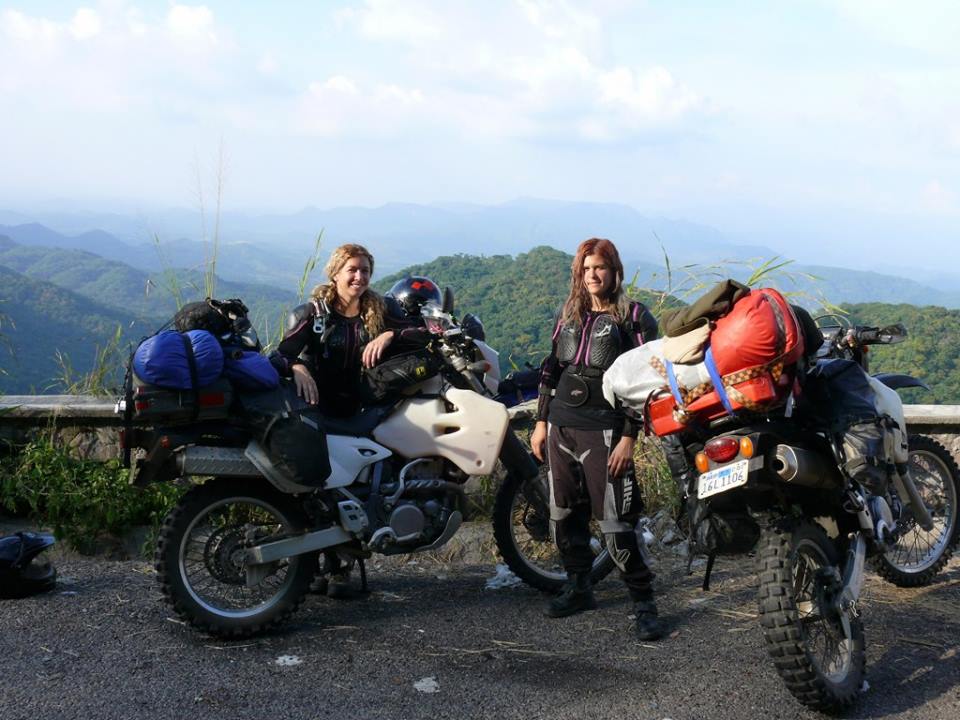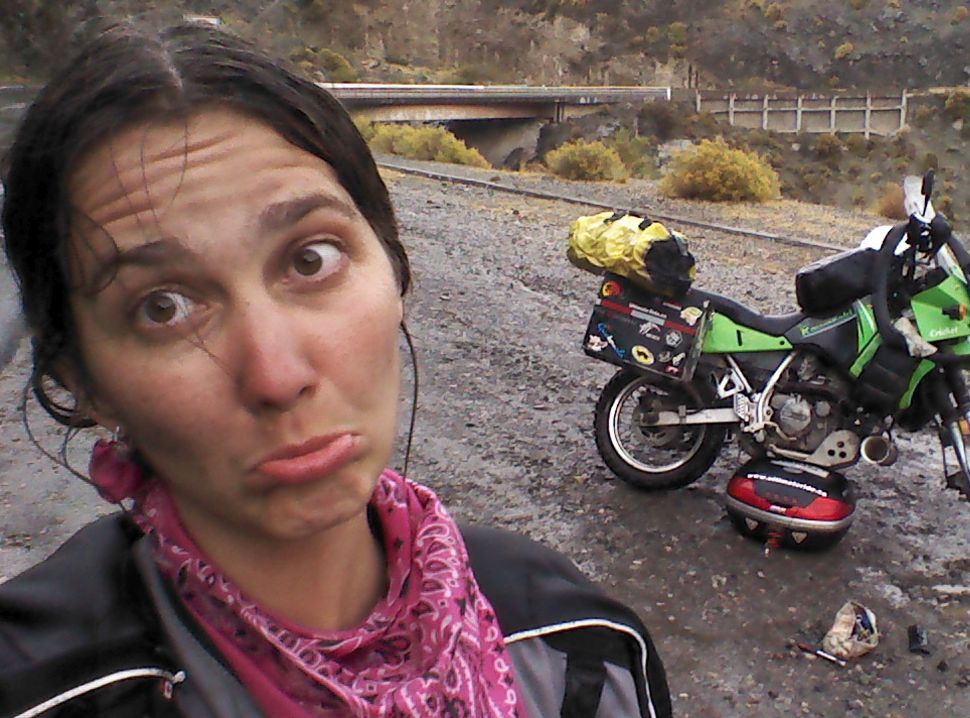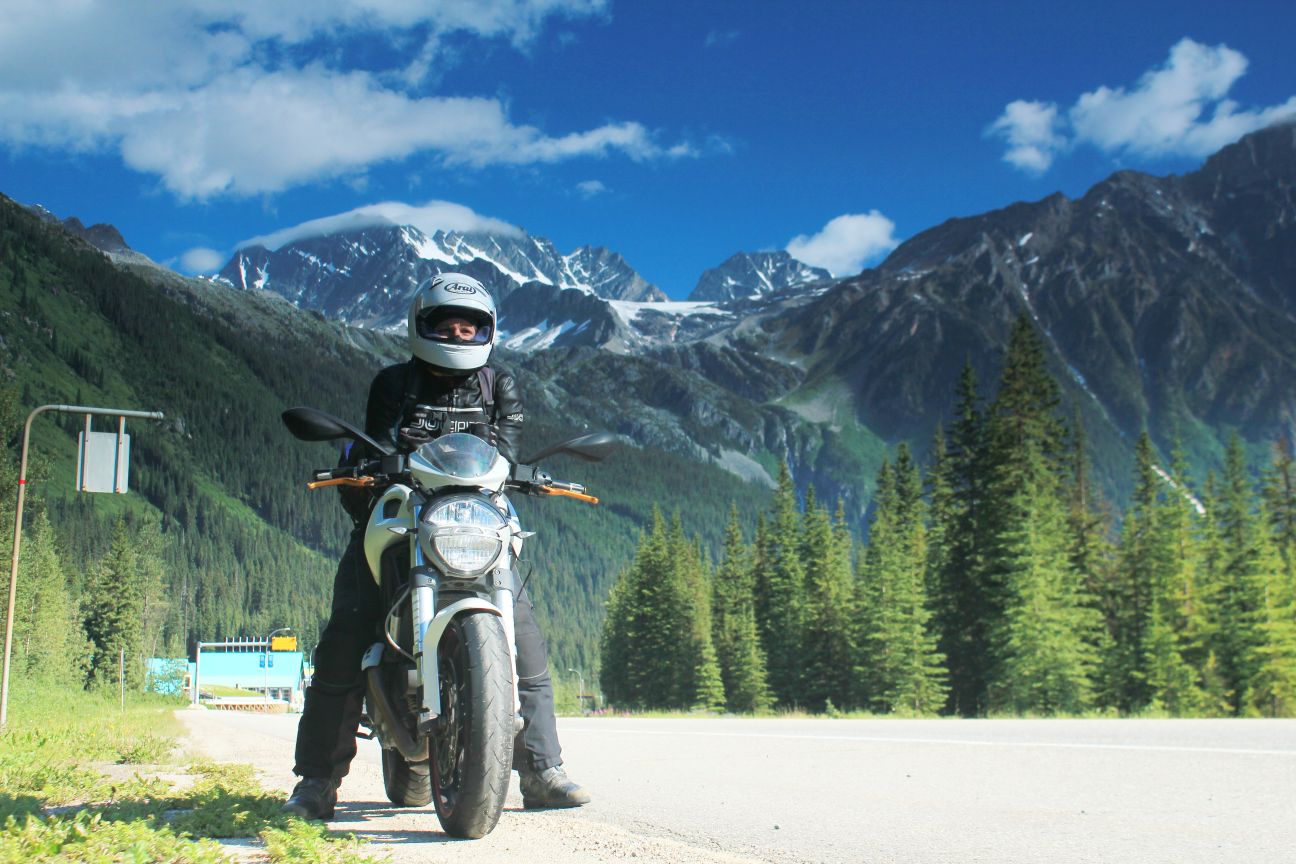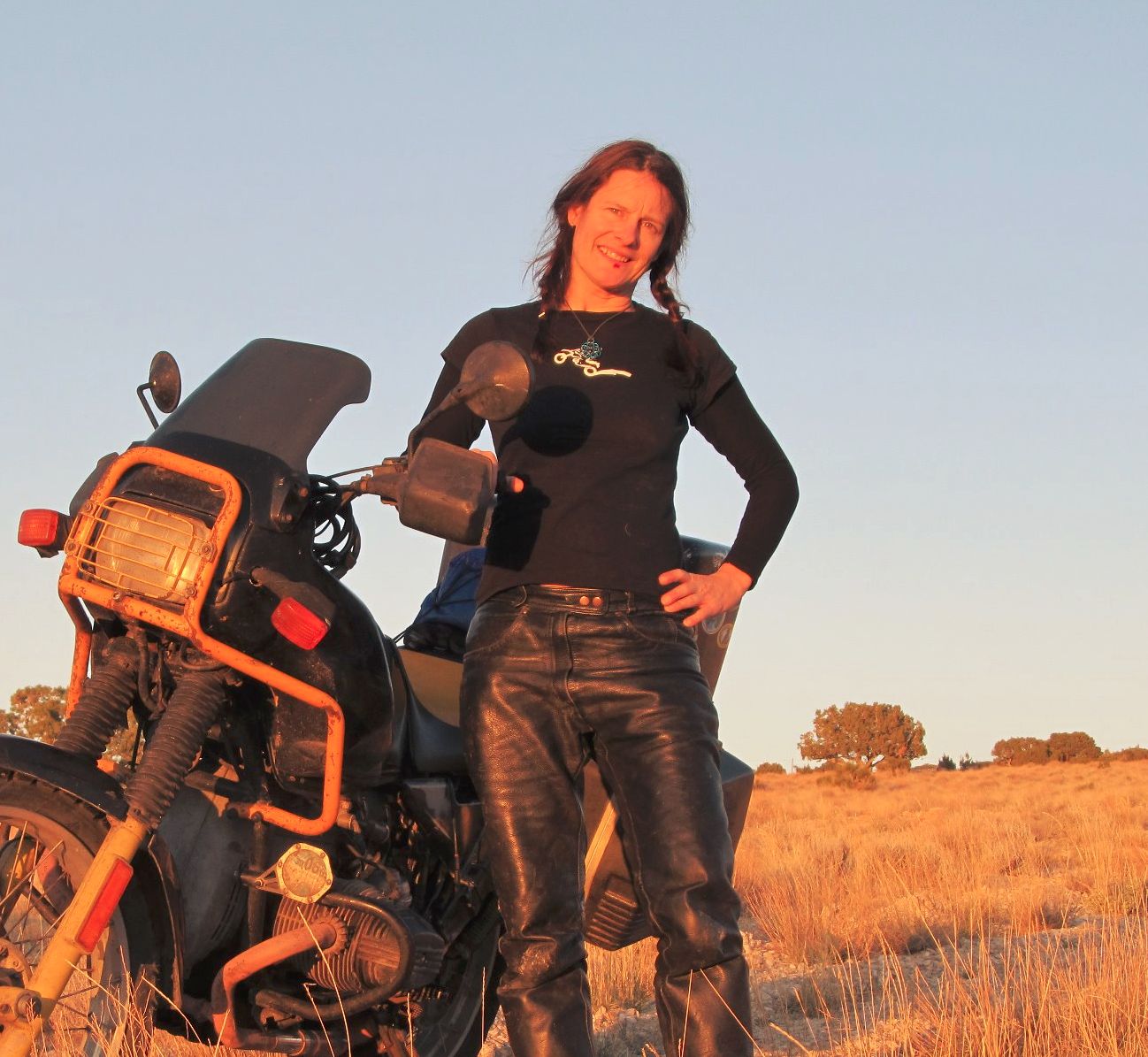Judy Kesler
Interviewing Judy Kessler from Alaska brought back a flood of memories from my ride to this beautiful, wild, rugged place in the summer of 2008 with my friend Sarah Adkins. Judy’s images of those lonely rough roads winding through unending wilderness, gorgeous glaciers, heavily loaded dual sport bikes, and tales of adventure riding make me long to relive the best parts of that near-magical time of my life. Alaska was and will always be one of the most beautiful places on this planet to me. I hope this interview provides inspiration to every rider who reads it and gives you a glimpse into the best that the United States has to offer to motorcyclists everywhere.
Rashmi Tambe
Editor, Global Women Who Ride
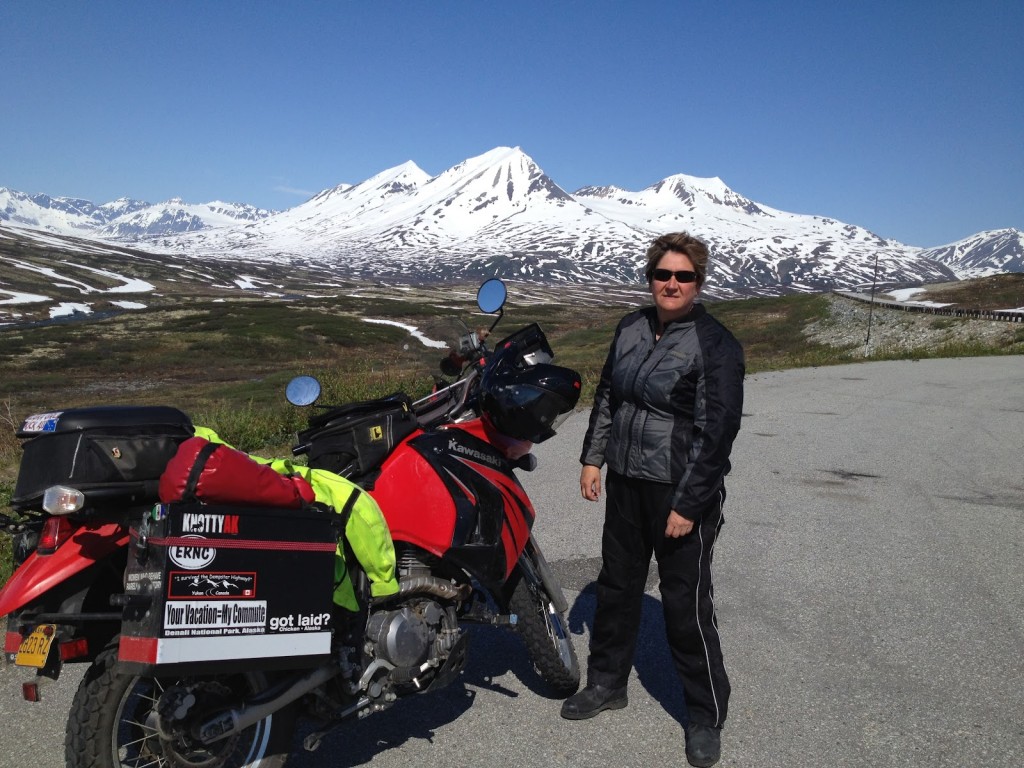
At the top of the summit on one of the prettiest roads in Alaska – the Haines Highway.
Please introduce yourself.
I work for the National Park Service in Alaska. I am the Regional Web Manager and manage 27 websites, including Denali National Park and Preserve.
For me, it is about the experience… I collect experiences. I am an adventurous person have traveled extensively, especially within Alaska. I have lived in Alaska for 22 years. During these 22 years, I have canoed the Yukon River, hiked on glaciers, and motorcycled every paved and dirt road in Alaska connected to the main road system. I want to ride my motorcycle around the world. I will be leaving in four years to start this adventure, and I am planning to be on the road for 5 years. I hope to write a few books about these travels and my experiences in Alaska. In addition to riding motorcycles, I enjoy riding my bicycle. I have pedaled across the United States twice, and I am planning to pedal the Continental Divide. I am married and have two adult children.
Describe your path into motorcycling.
I have always enjoyed moving. I got on my tricycle in 1967 and never looked back. I was a tomboy growing up. I was an avid skateboarder and cyclist. My mom would not allow me to ride motorcycles or dirt bikes. I was fascinated and drawn to them, either because I was told it was something a girl couldn’t do or because of the freedom they seems to offer. No matter how hard I tried, she wouldn’t let me near them. I recall watching the neighborhood boys riding a dirt bike in a field by my house when I was about 10. They were taking turns riding it. I wanted a turn but they wouldn’t let me ride it because I was a girl. I remember being really mad and thinking that it wasn’t fair. I turned that anger into drive and vowed I would find a way.
At 16, I got my first job. There was a boy that had several motorcycles that also worked there. Until that time, I wasn’t really interested in boys, but when I found out I could get access to motorcycles, I chased him down. He took me for a ride on his dirt bike. I was hooked and told him that I wanted him to teach me to ride by myself, not be a passenger. He spent the summer teaching me how to ride, and I have never looked back. He is now my husband of 30 years. He jokes that I was only really interested in the motorcycle. Together we have owned many motorcycles and traveled far. Today women can access motorcycles easily, but I recall a time when it just wasn’t all that possible. I am grateful to my husband Michael for believe that I could ride, and taking the time to teach. The world needs more men like him.
As for motorcycles, I love moving across the planet and interacting with the environment. When you are not trapped in a car, you can feel the wind, smell the air, sense the cold and warmth, get hit with bugs, you really are one with the land. When I am out on two wheels, I feel free and connected. It is simple. Traveling in this manner is my connection to freedom.
What bike did you first start on and why?
My very first motorcycle was a two stroke-dirt bike, a Honda Elsinore CR125M (1976). It was small and not very intimidating. It was the perfect motorcycle to learn on. I learned to ride in the desert of the Southwestern US. There was a lot of sand, and sagebrush, and miles of nothing. Learning on a small motorcycle is the best way to start, and if you can start off road, that would be my recommendation to women who want to get started with no experience. When you ride off road, you get a chance to understand the bike and how it works, the mechanics. You can practice with challenging terrain and not have to worry about other drivers or vehicles. You can just focus on learning, understanding how things work and growing into it. If you start small, your confidence can grow with your bike size. I rode this little red bike long enough to understand shifting, balance, and concepts.
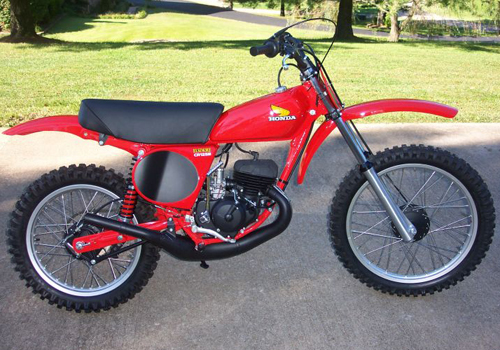
A Honda Elsinore 125
Describe your current bikes.
I have two right now – a BMW and a Kawasaki KLR, both of which are 650s. They are very different from each other. The BMW is smooth and rides like a dream on tarmac, very comfortable, but I still do not have confidence in the technical riding and dirt with it. I think it is more because I am afraid to damage it. Every time you drop a BMW it cost lots of money to fix it. I think I hold back for this reason. The BMW is parked in the lower 48 in Utah. This allows me access to motorcycle riding when there is ice and snow on the roads in Alaska.
My Alaska motorcycle is a workhorse. It is also very inexpensive to fix, and I feel more confident with this bike. It rides better off road, but riding on pavement is less pleasant. I don’t mind being riskier with this bike, so I think I ride well.
Both motorcycles were purchased with the concern of being able to touch the ground and ride off-road. If you have shorter legs, it can be uncomfortable riding larger bikes. The trade off for a lowered by and higher confidence is less clearance to do through really challenging terrain. I have bottomed out both of my bikes while riding. Last year, while riding the Petersville Road in Alaska – the ruts were so deep; my foot pegs were hitting the ground. This year, I am raising the height of that bike as lowered bikes just don’t have what it takes to get through really technical stuff.
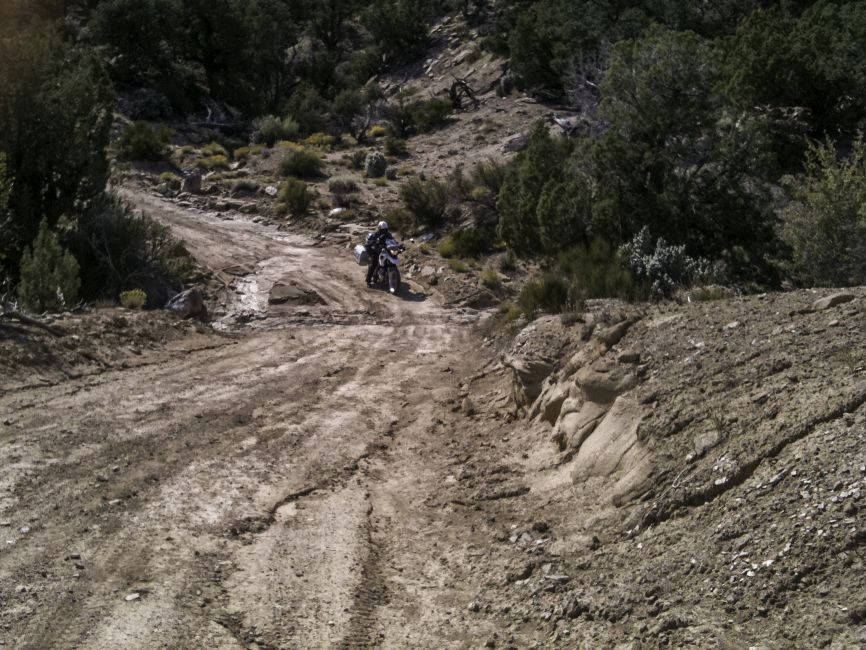
Is there a motorcycling achievement that you take pride in?
I recall when I was about 18 years old, I showed up to a big motorcycle camping outing where all the riders were boys. When they saw me, they moaned that I would hold them back. They took off and I not only kept up with them, I also surpassed the skills of many of the riders. By the end of the ride, I was riding second in the group. Later that evening, while many of the riders were parked and chatting, I came back into camp very fast and flew off a dirt pile and landed not far from where they were sitting. They never questioned my skills again. I felt proud and confident. All those years I had been told that girls couldn’t do something were left out on the trail that day. This was memorable to be me, because it was the time that I knew beyond a doubt that I could keep up. The one person that matters most is your own mind. Don’t let anyone convince you that you can’t do it.
Have you done any long distance road trips?
One epic road that stands out above the others is the Dempster Highway, Northwest Territories, Canada. The Dalton is Alaska’s northernmost road and the Demspter is Canada’s equivalent. Both are considered must-do roads for Alaska. The Dempster is roughly a 2000 mile round trip from Anchorage, AK, over 900 miles of which are dirt. Very few services exist on the way. Even gas can be a challenge. I like to tell people that the Dempster is a living breathing entity. Your experience on this road is decided 100% by the Dempster. It can choose to let you pass without too much trouble or it can snap and twist and literally break riders, make men cry, and convince women to turn back.
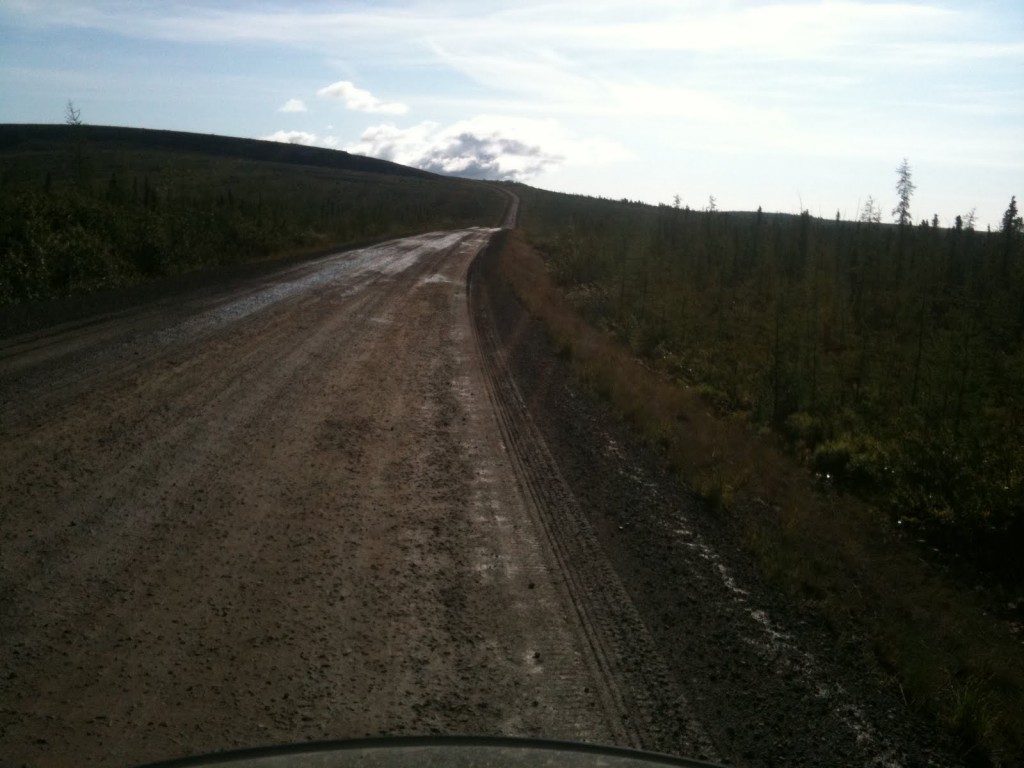
The long lonely road to Eagle, AK.
I have been on the Dempster twice, and each experience was challenging for different reasons. My first attempt was with a fellow woman rider. I opted to not ride by myself because I was worried that if I dropped the bike I would not be able to pick it up. She was the only one around who could take the time to ride. She was on a street bike – a Harley Davidson. I did not think she could make the entire trip on a bike like that, so I planned the trip as a ride on the Dempster to see what conditions were like. The road snapped and gave us extreme muddy conditions where I learned that there were 5 kinds of mud in the Arctic, most of them dangerous. It rained so much we got stuck waiting out the weather. During the 4 days we were on the road, there were 11 motorcycle riders total, out of which we were the only women. Five motorcycles crashed, 4 of the bikes were totaled, and one rider needed to be medivac-ed out. We rode up to the Arctic Circle and she called the ride at that point, stating that she didn’t want to die (which was a lot for her – she is crazy). We turned back, 190 miles short of the end. [Link to blog entry]
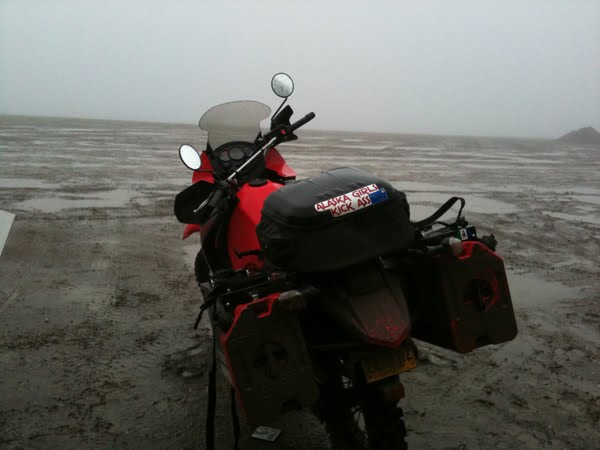
Jaz and I were holed up in Eagle Plains on the Dempster for 2 days waiting for conditions to improve.
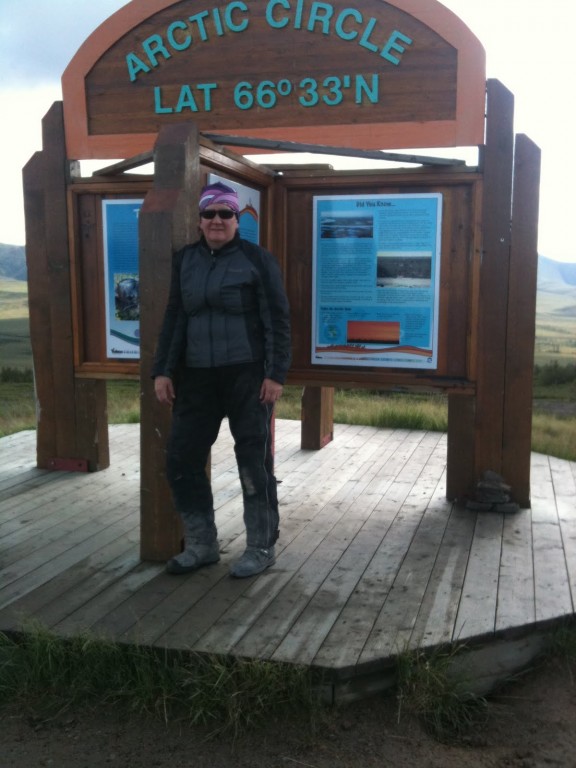
We turned around after reaching the Arctic Circle.
The second time I traveled the Dempster, I did it with my husband Michael. We completed the journey successfully, but on our return, Mother Nature once again wanted to show us that she was boss. The rain washed out the road, a death on the road closed down passage for one day, and a landslide up river from one of the ferry crossings, caused debris to float down the river and take out the ferry. We spent 6 days waiting around with the mosquitoes for roads and boats to be put back into operation. When we finally reached pavement again, I smiled.. the Dempster was epic! [Link to blog entry]
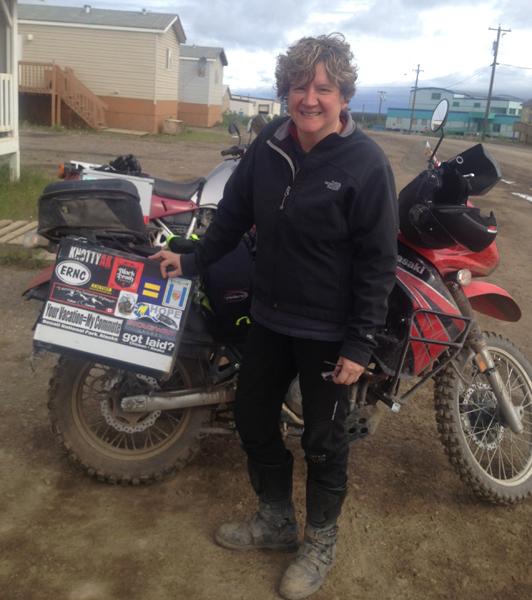
Stranded in Fort McPherson, Inuvik. Waiting out the time for the ferry boat to be repaired so we could cross the river.
Do you have any motorcycling heroes?
My husband Michael is my motorcycle hero. He takes the time to teach me skills in riding and motorcycle maintenance. He shares my dream of traveling around the world. He can dance on a motorcycle like no one I know. I want to ride like him someday, but he keeps getting better.
Tell us a good story from your travels.
When I used to live in Utah, Michael and I wanted to ride on the Bonneville Salt Flats. This is a wide open area on which world speed records have been set. We rode out to the flats and just took off northbound into the horizon. We rode and rode, not stopping for anything. After many miles I was getting tired and I started to slow down to stop. We were white from the salt dust. As I slowed down, I got disoriented because everything seemed to be warping and it didn’t make sense to me. I looked in front of me and the ground was bending. I was confused trying to understand what was happening. Michael started screaming at me to keep going. I looked back at him and saw that ground starting to crack and break up. Dark lines were forming and water was gushing from the cracks. It was very similar to the experience you would have with ice breaking around you on a frozen lake. We were riding on a crust of salt over water, and we never noticed when we left sold ground. I gave the bike full throttle and kept going, my weight no longer settling in one space, I was okay.
Michael however was heavier than I. Even though he was giving the bike throttle, he was falling through the crust of salt. His real tire had punched through, but was spinning on the edge breaking everything apart as he desperately tried to get out of there. The tire caught and he was able to get on top and move forward. We circled wide and raced back the way we came, not stopping until we were back on the road. It was one of the scariest riding memories of my life.
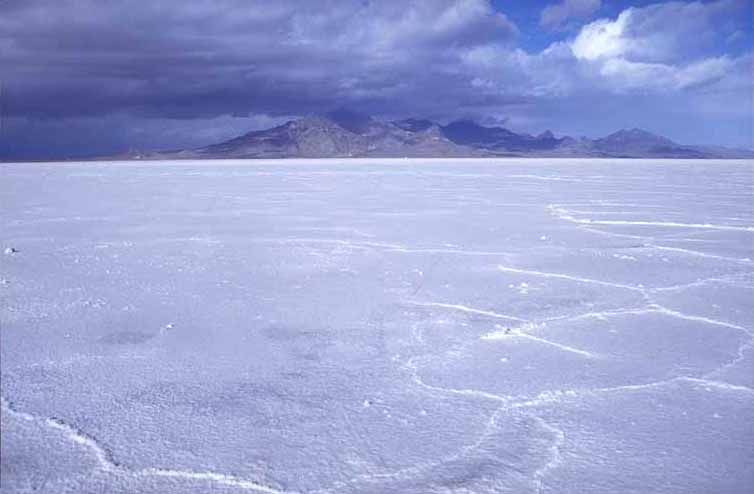
The Bonneville Salt Flats located in northern Utah, USA, is a densely packed salt pan. It is the home of the world major land speed events including the motorcycle speed records. Since 1956, all motorcycle world speed records have been set here. Photo Credit: US Government – Bureau of Land Management.
Have you formed any close female friendships due to motorcycling?
Jaz, my Harley riding crazy friend. I have never met anyone as nuts as her. Anyone who will ride a fully loaded Harely Davidson with street tires up the Dempster is crazy. We tend to have run-ins with the law when we ride together. We have been riding for years. She is my best riding buddy. Always have a sense of humor and enjoy the folks with you travel with.
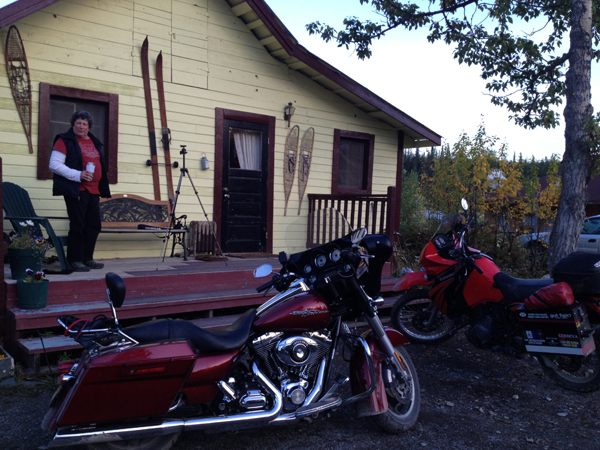
Jaz enjoys her coffee in the historic mining town of McCarthy where we are staying in what used to be a “house of ill-repute”.
Do you do maintenance and repairs on your bike?
Yes, I do work on my motorcycle. Although I travel a lot with Michael, I also like to travel by myself. I want to be able to troubleshoot my own problems and fix them if I have to. I have learned a lot over the years. The best way to learn is to do things all on your own and have someone knowledgeable looking over your shoulder. I’m fortunate that I have this. The times I have had a problem and needed to take it into a shop, I have asked the mechanic if I could sit back and watch while he worked on my bike. I haven’t been turned down yet. Traveling around the world extensively means you need to know how to fix your bike. That is part of riding. Don’t rely on others.
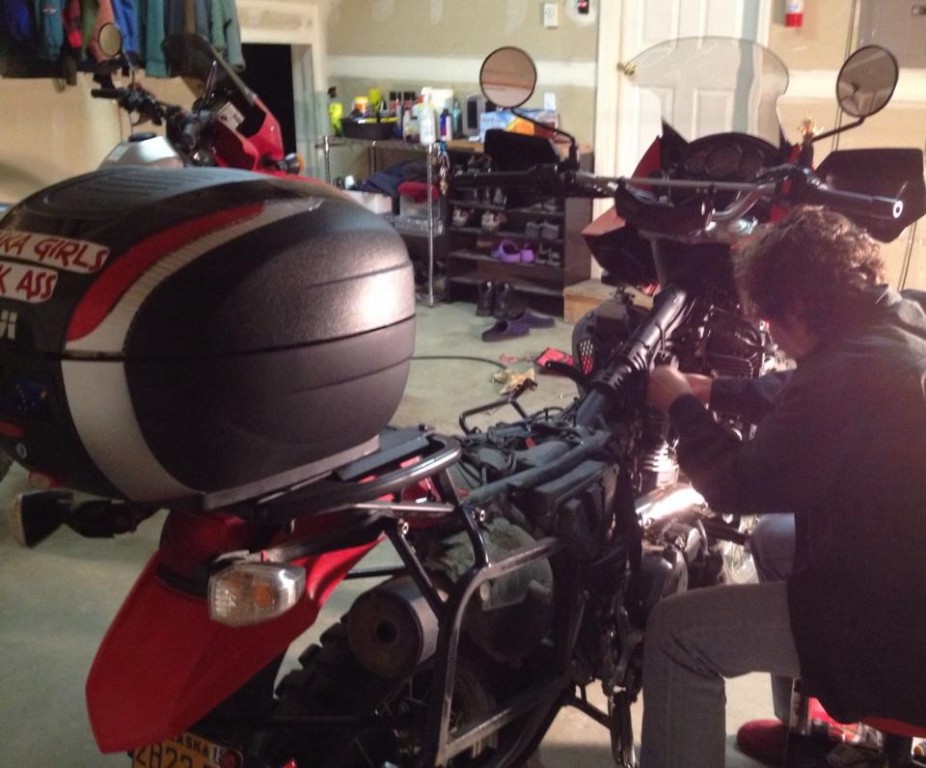
Doing some routine maintenance.
Do you have any advice for people who want to get into motorcycling?
Start slow at your comfort level and work your way up to bigger bikes as your confidence grows. Fear is the one thing that can cause you trouble and hold you back. Make sure you are riding for the right reasons. Don’t let someone push you into doing something you are uncomfortable or not ready for. When you fall, get back up. Don’t let the little voices of doubt get in your head and play havoc with your confidence. Take a break and walk it off. Learning to ride a motorcycle well and being able to take care of it is one of the largest catalysts for growth that I have ever experienced. Don’t let people say you can’t do it. Always ride safely, mitigating your risks before you get on the bike. Think like a woman – be rational, intelligent and thoughtful. Your safety depends on it. Don’t let fear stand in your way.
I recall the time I almost lost my life on a motorcycle due to a careless driver. It scared me so badly, that I gave up riding for a decade. The fear became greater than the joy and freedom of riding. My mind got wrapped up in “what-if’s” and paralyzed me with the fear. I never thought I would give up something I loved so much that had become part of my identity. Years later, the longing returned with a passion. Perhaps my children leaving home was the catalyst. My empty nest was filled with a BMW. I re-embraced my passion and have pushed my motorcycle riding to new lengths and levels since.
RIDING IN ALASKA
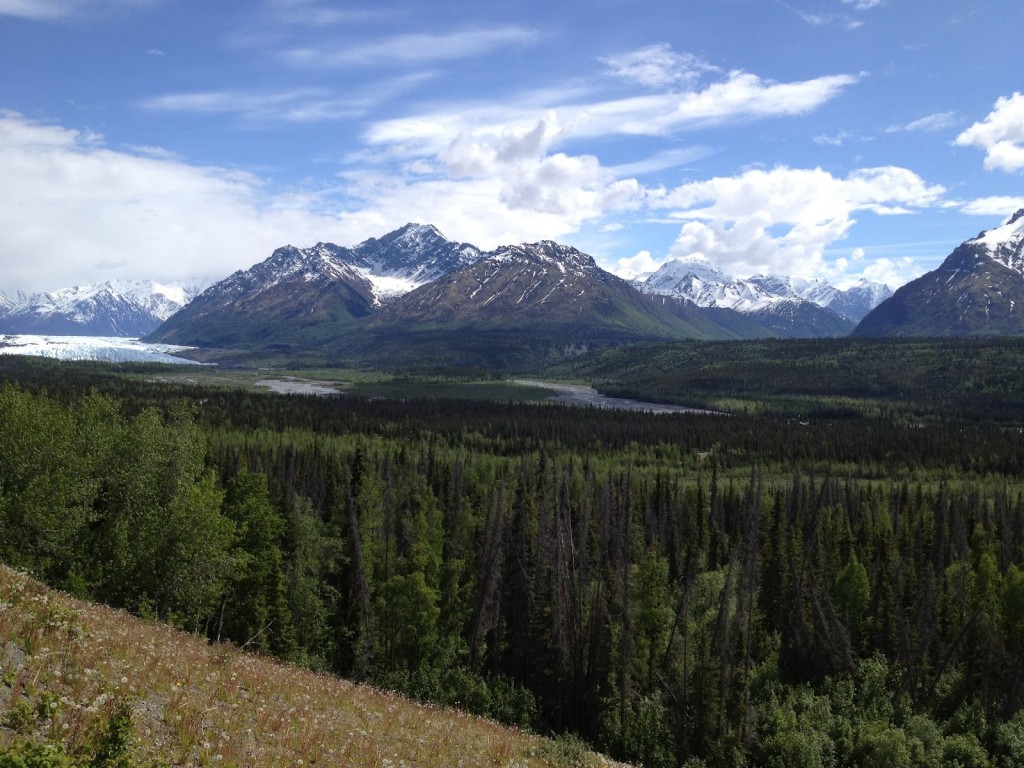
Matanuska Glacier, south of Glennallen
If I were to visit you and we went riding for one morning, where would you take me?
Everything is so spread out here in Alaska that in general one morning is not long enough to get to many destinations. If I had only one morning, I would go south of Anchorage to the Turnagain area. Beautiful mountains shoot out of the waters of the Cook Inlet, rising above sea level to nearly 4000 ft. The road stretches like a ribbon squeezed in-between the ocean and the foot of the mountains, waterfalls periodically cascade down from above. The smell of the ocean is in the air. If you’re lucky you will see Dall Sheep high above in the cliffs or the white humps of beluga whale in the inlet. The bore tide sometimes races you across the inlet. We would ride in this vista for 45 minutes before we arrived at a small town called Girdwood, where we would stop at the most awesome bakery in Alaska. After hot soup and a massive cinnamon roll we would turn back. The water always looks different coming back. [Link to map]
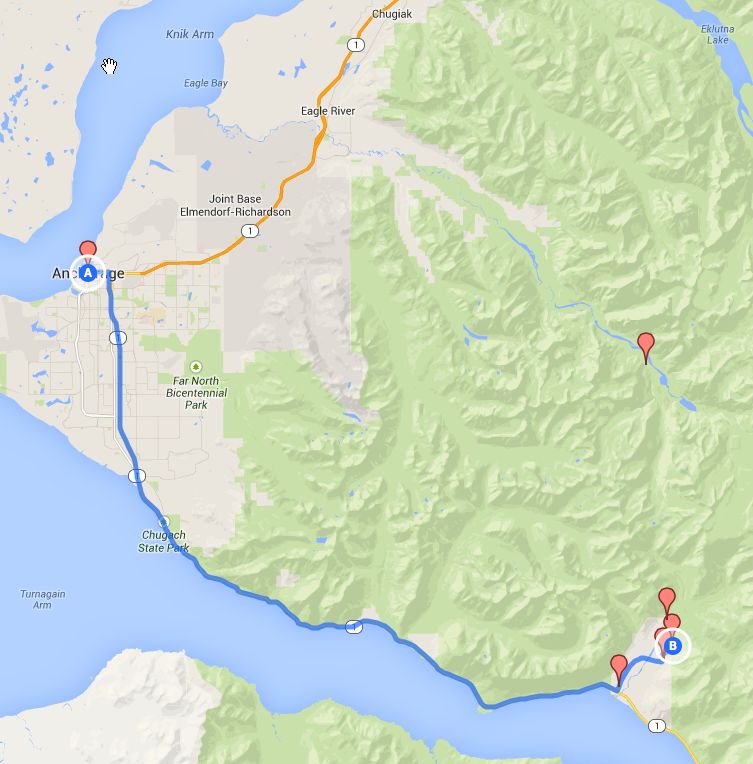
What’s the best part about riding in Alaska?
In Alaska, the riding takes on a different nature. You need to travel wisely and be self-sufficient. There may not be services for hundreds of miles beyond a gas station. You really need to understand the environment so that you can mitigate your risks. It offers an extra level of skill, challenge and excitement. You need to understand what camping around wild animals is like.
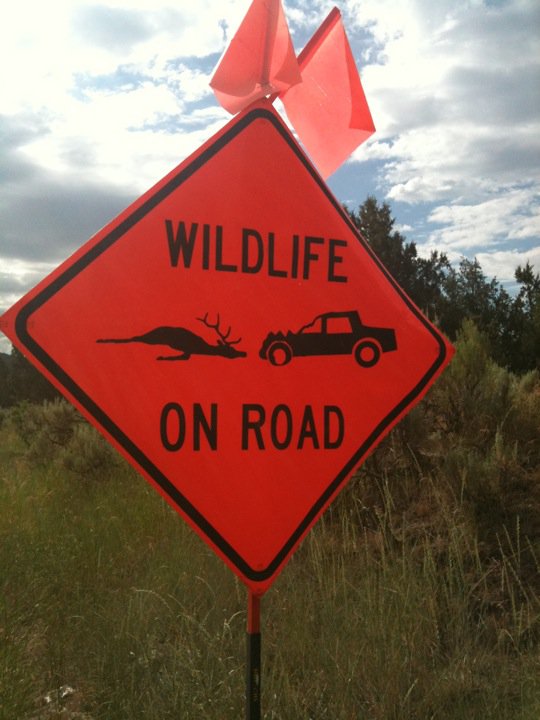
What are the top rides you would recommend in Alaska?
If passable – Copper River Highway near Cordova, via the Whittier Tunnel, ferry to Cordova, Alaska. Ride to Child Glacier and camp. It’s paved but you need to take a ferry and the Whittier tunnel can be frightening. Carry straps to secure your bike on boat crossings because they don’t provide them.
Top of the World Highway – Tok Alaska to Dawson, Yukon Territory. There is some paved but questionable tarmac.
Dempster Highway – Road to Inuvik, Northwestern Territory The ride starts in Alaska but ends in Canada. It’s the most challenging road I have done in Alaska/Canada, but experiences vary depending on the weather. It’s all dirt. Ferry crossings are part of the journey.
Haines Highway – Ride from Haines to Haines Junction. It’s paved and easy and amazing riding northbound.
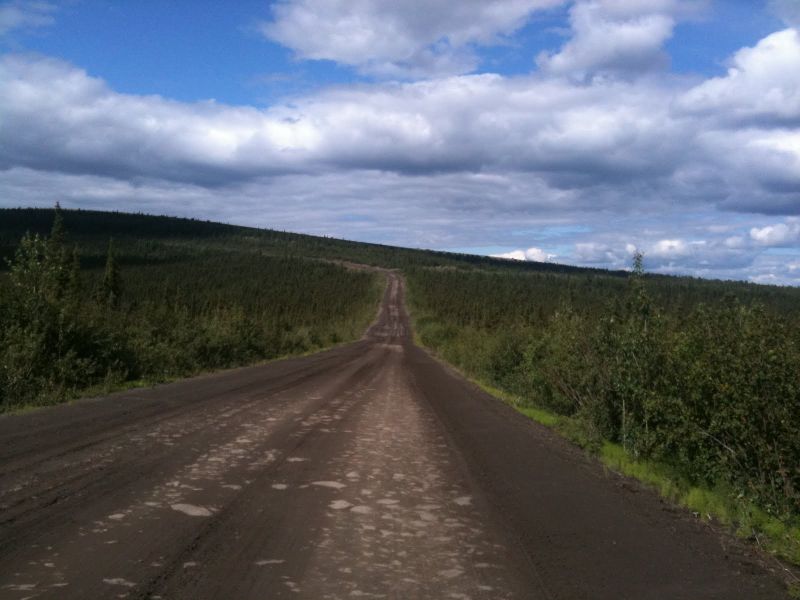
The long lonely road to Eagle, AK.
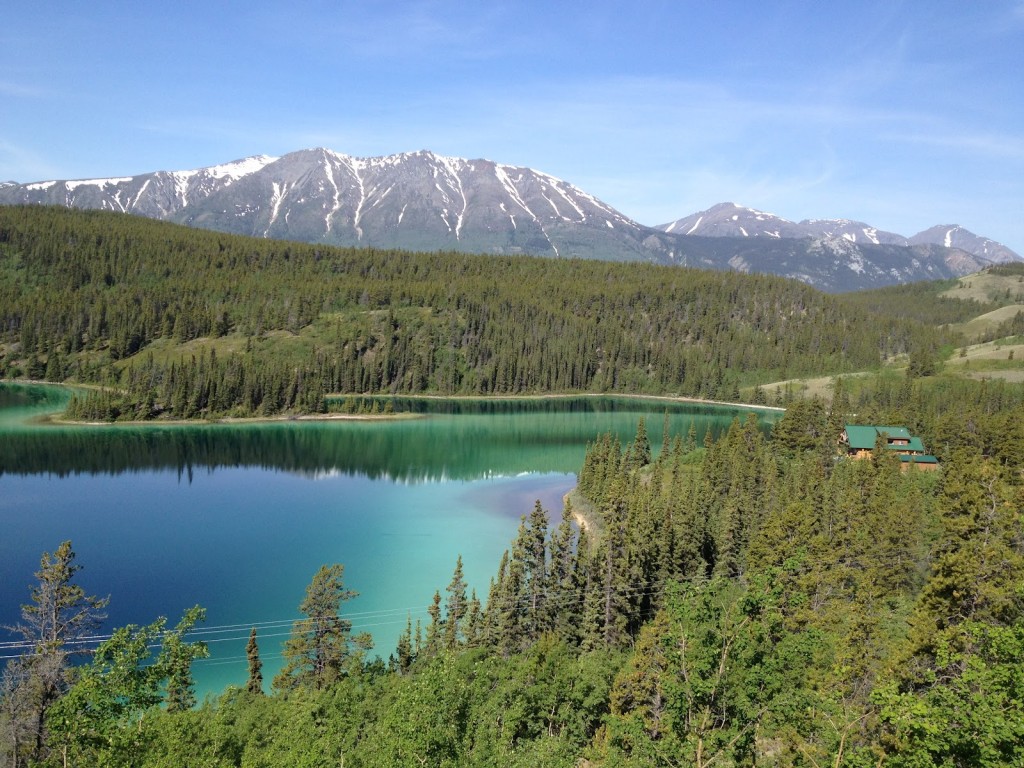
Emerald Lake, off of the Klondike Highway
What are the best months for riding there?
The season is very short in Alaska. The state is so large that conditions can be markedly different in the north than the south. Generally, the riding season is May–September everywhere. The season extends on both ends of this date range the farther south you are on the map. It is possible to have snow in May and September on the Dalton and Dempster. If I were planning a trip above the Arctic Circle, I would definitely shoot for June or early July. Be prepared for rain, rain, rain. Image 20 Although I know people who stud their tires and ride on the ice, I would not do that personally. I would consider riding a studded 3-wheeled vehicle during the winter months. You have to take care to prevent frostbite. Mosquitoes can be a challenge in the wetlands (most of Alaska). The further north you go, the more problematic it tends to be. Forest fires are common, making the air hard to breath.
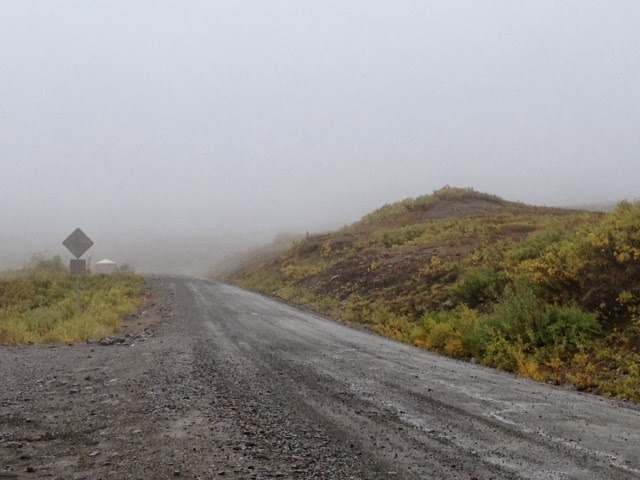
On the Denali Highway near Gracious House. Fog can limit visibility and challenge your riding.
How does the topography affect the kind of motorcycling you choose to do?
Most of the riding is lower elevation-sea level with only a few high mountain passes. The perma-frost conditions cause heaving of the tarmac – this can cause dangerous ripples across the roads. This can cause you to lose your balance at high speeds. In addition, the short construction season means there is always work on the roads. This generally manifests itself as large gravel patches in the middle of frost heaves. There is a lot of water here. For this reason, riding off road is not ideal. You will run into swampland, river crossings that are too high, and muddy glacial sediments that make it seem like you are riding on black grease. Some roads in Alaska area old railroad beds where the remnants of rotting railroad ties (wood) poke up through the dirt waiting to pop a tire. Always be able to change your own tire and carry the right equipment to fix a flat. Sticking to the roads is the only option for motorcycles. The rainy season limits which of those roads are passable. Fog can also be an issue.
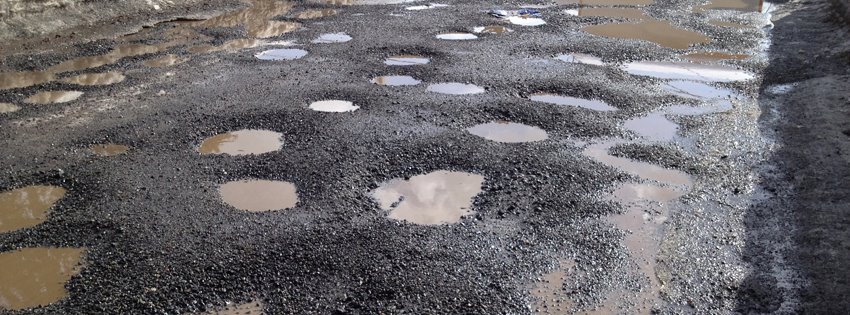
Potholes are common even in Anchorage
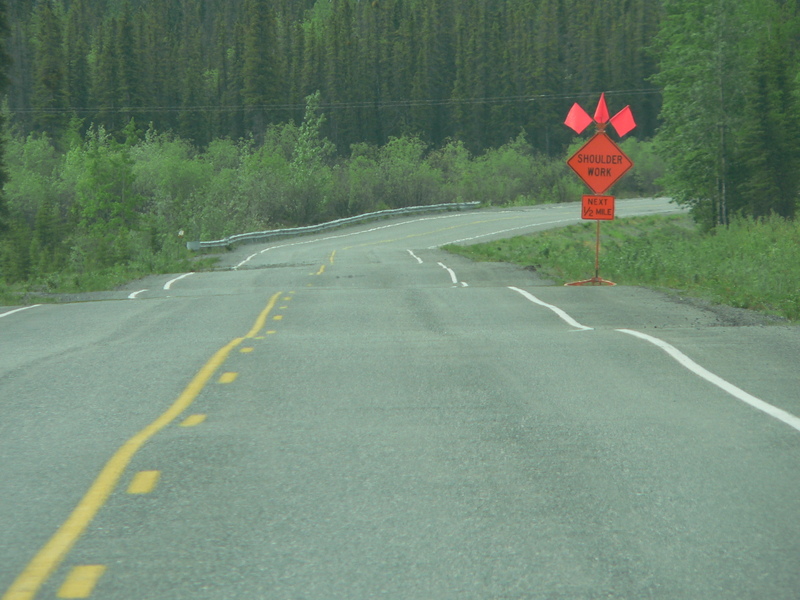
Frost heaving occurs when ice forms under the pavement. The freezing and thawing causes the road to buckle and push up, creating a wave-like ridge. Frost heaves are very dangerous for motorcyclists.
Is it safe to ride at night where you live?
The sun does not set for very long during the month of June after the summer solstice. The first part of July and the last part of May are also long days. When you have light you can see the condition of the road and wildlife on the road. These are the safest times to ride at night. Once it becomes dark, it can be dangerous. The nice thing about Alaska is that during most of the riding season, the days are long and when the sun sets it takes time. Unless it is either really early or really late, your energy will be long gone before the light.
Is there a local motorcycling event that you try and attend regularly?
I try to avoid group gatherings as much as possible. Once I attended a Women’s Rally but there were too many people and I didn’t enjoy myself since I am a bit of a loner. In Alaska, the only major group event for dual sport motorcycles is the Dust to Dawson. When I am outside of Alaska, I have attended the Overland Expo in the Lower 48.
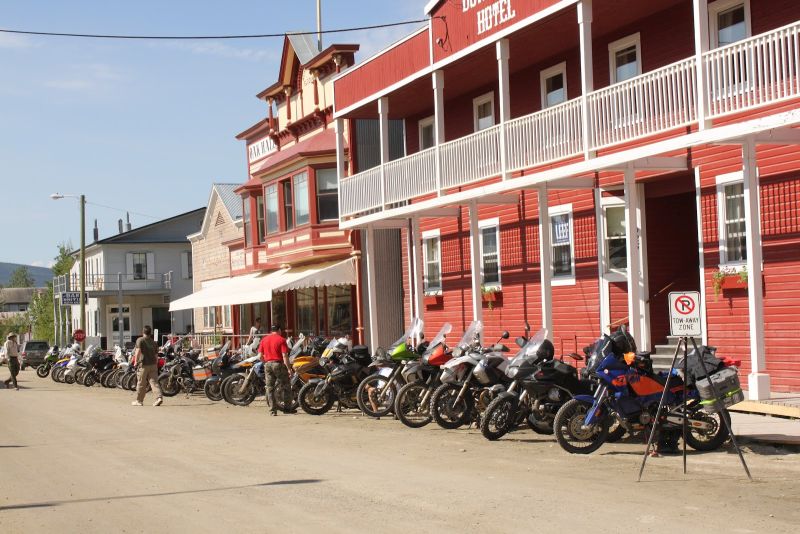
The streets of Dawson, Yukon Territory are lined with dual sport motorcycles from Alaska and Canada during the summer solstice (June 21st) every year.
Are there any motorcycle specific laws?
You must have a motorcycle class (MC) license. This requires that you take a written test as well as a riding motorcycle test. In Alaska, you can sign up for a motorcycle safety course that lasts a couple of days, and in the end, they actually test your riding skills. If you pass the test, they give you a certificate that you trade in at the time you take the written test. If you pass both you get a license. Helmet laws vary from state to state. If you are over the age of 18, you can chose not to wear a helmet.
Are motorcyclists discriminated against in any way?
I do not believe motorcyclists are discriminated against in Alaska. At one time, I have felt discrimination in the form of limited options to ride on account of being a woman. The belief was that women could not develop the skills to ride and would therefore be a risk to herself and others. I experienced this in the 1970s and 1980s. Perhaps it is still around, but I just don’t care anymore and don’t notice. Today I find lots of women riding. The number of women who participate in motorcycling seems to be higher for touring and cruising bikes. The percentage of female riders on dual sports seems lower. Sometimes it is hard to find another female dual sport rider in Alaska to go on rides with.
How do the police treat motorcyclists?
The police treat motorcyclists the same. I’m not sure if I attract the police. It never fails – I have repeated runs-in with the law. Mostly because I am riding off road in areas that tend to be monitored by troopers, border patrol, and park rangers. They generally stop me to see if I am doing anything illegal. I suppose smuggling is generally the concern.
What is the traffic like and how does it affect motorcycle riding?
During the winter, most people ride with studded snow tires on their cars. This coupled with road conditions like melting permafrost and frost heaves tends to make the roads in Alaska interesting. The studs make deep ruts in the pavement that can sometimes be interesting to drive across. The heaves create “roller coaster” or waves in the pavement that can catch you off guard if you are not paying attention. Add cars on the road, and conditions can be challenging. Traffic is not bad in the cities, but because we have only a few roads, motor home or recreational vehicles can clog the roads and cause the traffic to back up. During fishing season, when folks are in a hurry to get out and back, traffic passes these motor homes, many times in an unsafe manner. It can get a little nerve racking dealing with traffic darting across the double lines or passing unsafely. Wild animals – specifically moose – can also be problematic.
How do car drivers treat motorcycle riders on the road?
Most people are distracted these days with their electronic devices. Although it is illegal to text and drive in Alaska, it is not uncommon to see people staring at their phones while driving. Always drive defensively here. Don’t go unless you make eye contact with the drivers around you and they see you. This applies mostly to city driving, and in Alaska we don’t have too many cities. It is probably safer here from these types of risks then in the Lower 48. When you are traveling in remote places. If you have problems, people will stop to help you out.
Is motorcycle theft a problem?
I don’t worry about my motorcycle too much, although it happens. I always lock my handlebars so the bike can’t be rolled away. I never leave my bags unlocked on my bike, unless I can see it. I have not had anything stolen from my bike in all the years I have been riding, but I also pay attention.
How are women motorcycle riders treated by most people and by male motorcyclists?
Today there seems to be little difference.
Do you have access to high quality motorcycling gear in your part of the world?
Yes, we can get almost anything here.
Do female and male motorcyclists have the same amount of freedom to pursue motorcycling activities?
Yes. Over the past two decades it seems that more and more women are now pursuing riding. More riders create more opportunities. Don’t be afraid to ride by yourself. There are different kinds of rides and adventures and part of that includes whom you ride with. I like to ride by myself for many reasons. One of the benefits of riding by yourself is that you continue to build confidence in your skill set and tackle small problems on your own. Even tackling problems that are not related to the mechanics of the bike or camping offer opportunities for growth.
If you would like to be a part of the Global Women Who Ride series, please email submissions@globalwomenwhoride.com.

